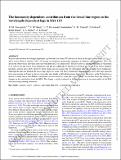Files in this item
The luminosity-dependent contribution from the broad line region to the wavelength-dependent lags in Mrk 110
Item metadata
| dc.contributor.author | Vincentelli, F M | |
| dc.contributor.author | McHardy, I | |
| dc.contributor.author | Santisteban, J V Hernández | |
| dc.contributor.author | Cackett, E M | |
| dc.contributor.author | Gelbord, J | |
| dc.contributor.author | Horne, Keith | |
| dc.contributor.author | Miller, J A | |
| dc.contributor.author | Lobban, A | |
| dc.date.accessioned | 2022-02-23T12:30:03Z | |
| dc.date.available | 2022-02-23T12:30:03Z | |
| dc.date.issued | 2022-01-29 | |
| dc.identifier | 277770247 | |
| dc.identifier | 29e02910-473c-483d-8236-42e83360d4ae | |
| dc.identifier | 85126750399 | |
| dc.identifier.citation | Vincentelli , F M , McHardy , I , Santisteban , J V H , Cackett , E M , Gelbord , J , Horne , K , Miller , J A & Lobban , A 2022 , ' The luminosity-dependent contribution from the broad line region to the wavelength-dependent lags in Mrk 110 ' , Monthly Notices of the Royal Astronomical Society: Letters , vol. Advance Article . https://doi.org/10.1093/mnrasl/slac009 | en |
| dc.identifier.issn | 1745-3925 | |
| dc.identifier.other | Jisc: e0f2bb6574f745fc95d7ff1a70313aee | |
| dc.identifier.other | ORCID: /0000-0002-6733-5556/work/108919214 | |
| dc.identifier.uri | https://hdl.handle.net/10023/24935 | |
| dc.description | Funding: FMV and IMH were supported for this work by the STFC grant ST/R000638/1. JVHS and KDH acknowledges support from STFC grant ST/R000824/1. EMC & JM gratefully acknowledge support from the NSF through grant AST-1909199. | en |
| dc.description.abstract | We have measured the wavelength-dependent lags between the X-ray, UV and optical bands in the high accretion rate (L/LEdd≈40 per cent) Active Galactic Nucleus Mrk 110 during two intensive monitoring campaigns in February and September 2019. We divide the observations into three intervals with different X-ray luminosities. The first interval, already published in Vincentelli et al. (2021), has the lowest X-ray luminosity and did not exhibit the U-band excess positive lag, or the X-ray excess negative lag that is seen in most AGN. However, these excess lags are seen in the two subsequent intervals of higher X-ray luminosity. Although the data are limited, the excess lags appear to scale with X-ray luminosity. Our modelling shows that lags expected from reprocessing of X-rays by the accretion disc vary hardly at all with increasing luminosity. Therefore, as the U-band excess almost certainly arises from Balmer continuum emission from the broad line region (BLR), we attribute these lag changes to changes in the contribution from the BLR. The change is easily explained by the usual increase in the inner radius of the BLR with increasing ionising luminosity. | |
| dc.format.extent | 6 | |
| dc.format.extent | 826622 | |
| dc.language.iso | eng | |
| dc.relation.ispartof | Monthly Notices of the Royal Astronomical Society: Letters | en |
| dc.subject | Galaxies: active | en |
| dc.subject | Galaxies: individual: Mrk 110 | en |
| dc.subject | Accretion | en |
| dc.subject | Accretion discs | en |
| dc.subject | QB Astronomy | en |
| dc.subject | QC Physics | en |
| dc.subject | DAS | en |
| dc.subject.lcc | QB | en |
| dc.subject.lcc | QC | en |
| dc.title | The luminosity-dependent contribution from the broad line region to the wavelength-dependent lags in Mrk 110 | en |
| dc.type | Journal article | en |
| dc.contributor.sponsor | Science & Technology Facilities Council | en |
| dc.contributor.institution | University of St Andrews. School of Physics and Astronomy | en |
| dc.contributor.institution | University of St Andrews. St Andrews Centre for Exoplanet Science | en |
| dc.identifier.doi | https://doi.org/10.1093/mnrasl/slac009 | |
| dc.description.status | Peer reviewed | en |
| dc.identifier.grantnumber | ST/R00824/1 | en |
This item appears in the following Collection(s)
Items in the St Andrews Research Repository are protected by copyright, with all rights reserved, unless otherwise indicated.

